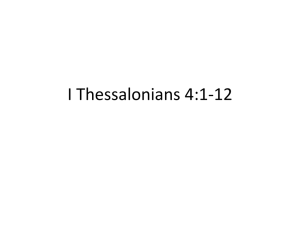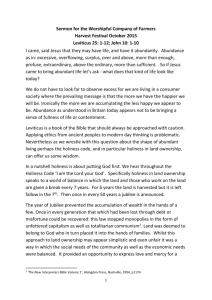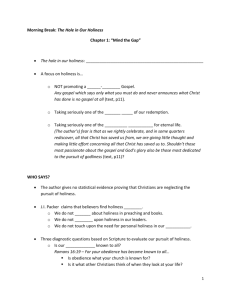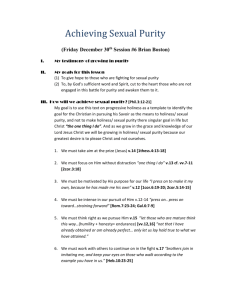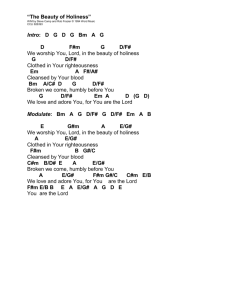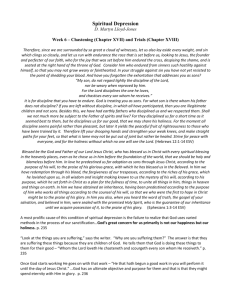Re-Appropriating The Biblical Language of Purity and Cleansing for
advertisement
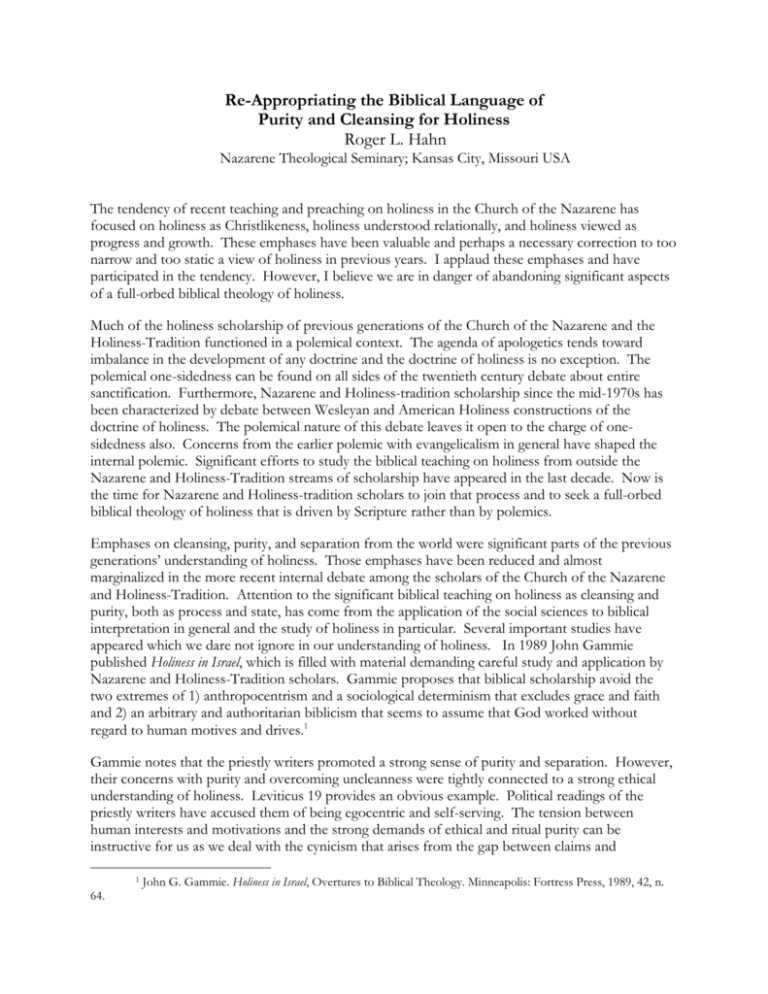
Re-Appropriating the Biblical Language of Purity and Cleansing for Holiness Roger L. Hahn Nazarene Theological Seminary; Kansas City, Missouri USA The tendency of recent teaching and preaching on holiness in the Church of the Nazarene has focused on holiness as Christlikeness, holiness understood relationally, and holiness viewed as progress and growth. These emphases have been valuable and perhaps a necessary correction to too narrow and too static a view of holiness in previous years. I applaud these emphases and have participated in the tendency. However, I believe we are in danger of abandoning significant aspects of a full-orbed biblical theology of holiness. Much of the holiness scholarship of previous generations of the Church of the Nazarene and the Holiness-Tradition functioned in a polemical context. The agenda of apologetics tends toward imbalance in the development of any doctrine and the doctrine of holiness is no exception. The polemical one-sidedness can be found on all sides of the twentieth century debate about entire sanctification. Furthermore, Nazarene and Holiness-tradition scholarship since the mid-1970s has been characterized by debate between Wesleyan and American Holiness constructions of the doctrine of holiness. The polemical nature of this debate leaves it open to the charge of onesidedness also. Concerns from the earlier polemic with evangelicalism in general have shaped the internal polemic. Significant efforts to study the biblical teaching on holiness from outside the Nazarene and Holiness-Tradition streams of scholarship have appeared in the last decade. Now is the time for Nazarene and Holiness-tradition scholars to join that process and to seek a full-orbed biblical theology of holiness that is driven by Scripture rather than by polemics. Emphases on cleansing, purity, and separation from the world were significant parts of the previous generations’ understanding of holiness. Those emphases have been reduced and almost marginalized in the more recent internal debate among the scholars of the Church of the Nazarene and Holiness-Tradition. Attention to the significant biblical teaching on holiness as cleansing and purity, both as process and state, has come from the application of the social sciences to biblical interpretation in general and the study of holiness in particular. Several important studies have appeared which we dare not ignore in our understanding of holiness. In 1989 John Gammie published Holiness in Israel, which is filled with material demanding careful study and application by Nazarene and Holiness-Tradition scholars. Gammie proposes that biblical scholarship avoid the two extremes of 1) anthropocentrism and a sociological determinism that excludes grace and faith and 2) an arbitrary and authoritarian biblicism that seems to assume that God worked without regard to human motives and drives.1 Gammie notes that the priestly writers promoted a strong sense of purity and separation. However, their concerns with purity and overcoming uncleanness were tightly connected to a strong ethical understanding of holiness. Leviticus 19 provides an obvious example. Political readings of the priestly writers have accused them of being egocentric and self-serving. The tension between human interests and motivations and the strong demands of ethical and ritual purity can be instructive for us as we deal with the cynicism that arises from the gap between claims and 1 64. John G. Gammie. Holiness in Israel, Overtures to Biblical Theology. Minneapolis: Fortress Press, 1989, 42, n. 2 performance in the holiness tradition. Gammie points out that the priestly writers had a “strong doctrine of sin” as they sought the restoration of purity and separation from uncleanness.2 Our tendency to ignore the Old Testament passages dealing with ritual purity in favor of the ethical treatments of Holiness causes us to bifurcate the creative tension between purity and ethics found in the biblical authors. The problem is not simply an Old Testament issue. The New Testament words and phrases such as “spotless”, “blameless”, and “without blemish” build on Old Testament assumptions of ritual purity. To interpret such phrases without regard to the Old Testament understandings of the relationship of ethics and ritual purity fails to appropriate an important aspect of biblical thinking. Within the prophets the great ethical vision of social justice found in Isaiah comes from one whose call focused on his need for cleansing. The perspectives on holiness presented in Conflict, Holiness, and Politics in the Teachings of Jesus by Marcus J. Borg offer one avenue for understanding a Christian response to the Old Testament and Jewish understandings of Holiness.3 The way in which Jesus prioritized table fellowship over ritual purity in his conflicts with Pharisees suggests that he was dismissing the Old Testament and Jewish understanding of holiness for his alternative vision of holiness. However, Jesus’ regular appropriation of the temple and cleansing language and his constant instruction to lepers to show themselves to the priests indicates that the matter is not so simple. Borg points toward compassion, the imitation of God, and transformation as important elements in Jesus’ quest for holiness. However, the evidence suggests that Jesus was not rejecting the Old Testament vision of holiness out of hand. Rather he was transforming it by reconnecting it to the nature of God. Jesus’ teaching on holiness and its relationship to Jewish/Old Testament understandings of ritual purity offers an important resource for Nazarene and Holiness-Tradition scholars seeking to understand the connectedness of the nature of God, ethics, and the language of ritual purity. The number of references in the New Testament to cleansing is almost equal to the number of times it speaks of sanctification. The concepts of faith and the death of Christ are closely related to both cleansing and sanctification. This suggests that the relationship between holiness understood relationally and holiness as purity needs to be explored and carefully defined. Social scientific studies in the laws of ritual purity have opened the possibilities of significant new insights for our understanding of holiness if we will commit ourselves to the patient scholarship required. These are not days to abandon the language of purity, cleansing, and separation. As the cultural diversity of the Church of the Nazarene increases we must not reduce or narrow our understanding. Rather, we must move beyond reactions created by our polemics and patiently ponder the rich diversity of holiness found in the Scriptures. Gammie, 42-44. Marcus J. Borg. Conflict, Holiness, and Politics in the Teachings of Jesus, New Edition with Foreword by N.T. Wright. Harrisburg, PA: Trinity Press International, 1998. 2 3

